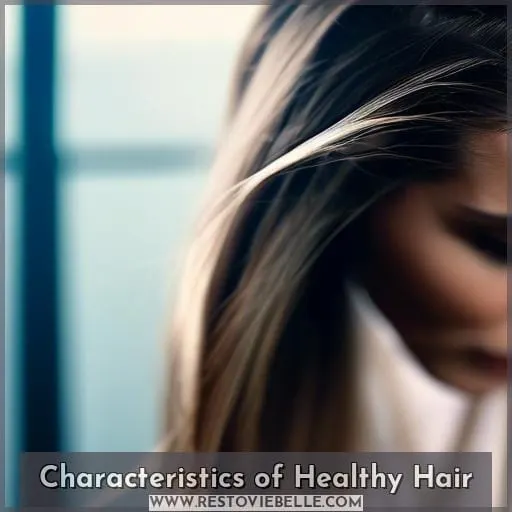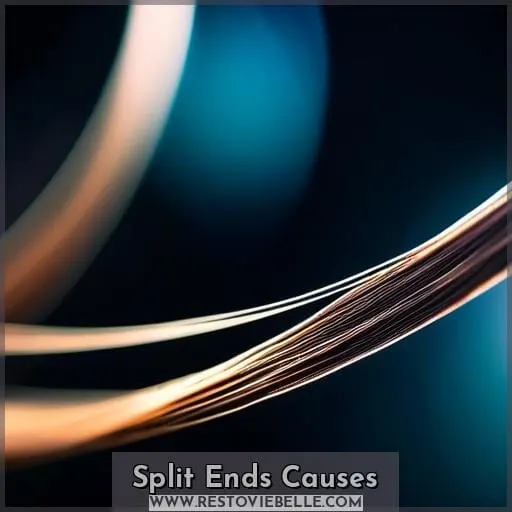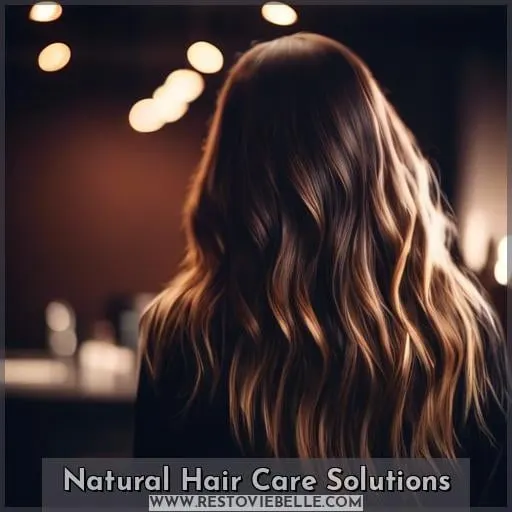This site is supported by our readers. We may earn a commission, at no cost to you, if you purchase through links.
 Struggling with split ends can feel like a never-ending battle, but understanding the difference between damaged tips and healthy hair is key to achieving those lustrous, strong locks you’re after.
Struggling with split ends can feel like a never-ending battle, but understanding the difference between damaged tips and healthy hair is key to achieving those lustrous, strong locks you’re after.
Split ends, or trichoptilosis, betray hair that’s been through the wringer—be it from heat styling, harsh chemicals, or environmental stressors. On the flip side, healthy hair boasts a smooth cuticle, natural shine, and resilience.
Dive into the world of hair care with us as we explore how to spot, prevent, and treat split ends, ensuring your hair’s vitality for the long haul.
Table Of Contents
- Key Takeaways
- Understanding Split Ends
- Characteristics of Healthy Hair
- Split Ends Causes
- Split Ends Prevention
- Natural Hair Care Solutions
- Treating Existing Split Ends
- Maintaining Hair Health
- Frequently Asked Questions (FAQs)
- How does the water quality in my area affect the health of my hair and its susceptibility to split ends?
- Can dietary changes or supplements improve hair strength and reduce the occurrence of split ends?
- Are there specific hair brushing techniques that minimize damage and help prevent split ends?
- How does hair porosity influence the development of split ends and the effectiveness of hair care products?
- Can wearing hats or head coverings frequently contribute to the formation of split ends?
- Conclusion
Key Takeaways
- Split ends are a manifestation of hair damage, which can be caused by environmental factors, chemical treatments, heat styling, and mechanical stress, and they can lead to further hair breakage and thinning if not addressed.
- Healthy hair is characterized by a smooth, tightly packed cuticle, natural shine, and resilience, which reflects good hair care habits and is less prone to damage such as split ends.
- Preventing split ends involves regular hair trims, moisturizing routines, protective styling, and gentle handling to maintain hair integrity and prevent further damage.
- While conditioning treatments can improve the appearance of hair, they cannot repair split ends; the only definitive solution for split ends is to trim them off to prevent potential escalation of damage.
Understanding Split Ends
To grasp the essence of split ends, or trichoptilosis, it’s crucial to understand their impact on hair health. These pesky ends are more than just a visual nuisance; they signal deeper damage within the hair shaft, caused by factors like mechanical stress, heat, and chemical treatments.
Recognizing the various types of split ends, from the common Y split to more complex forms like the tree or feather split, is the first step in addressing and ultimately preventing them. This knowledge empowers you to adopt healthier hair practices, ensuring your locks remain lustrous and strong.
Trichoptilosis Explained
Split ends, scientifically known as trichoptilosis, occur when the protective cuticle of the hair is damaged, leading to the splitting of the hair strand into two or more parts.
These can take various forms, including the traditional Y split, double Y split, and more complex shapes like tree and fork splits.
Split ends aren’t only a cosmetic issue but also indicate underlying hair damage, which can result in hair breakage and thinning.
Types of Split Ends
As you continue to learn about the health of your hair, it’s important to recognize the various types of split ends that can occur. These imperfections not only detract from your hair’s appearance but also indicate underlying damage.
- Traditional Y Split: The classic sign of hair needing a trim.
- Fork Split: Multiple splits occurring at the end of a single strand, suggesting severe damage.
- Taper Split: A gradual thinning towards the end, often less noticeable but indicative of wear.
Understanding these can guide you towards healthier hair practices.
Characteristics of Healthy Hair
When assessing the health of your hair, the integrity of the cuticle and the texture and shine of your strands are key indicators.
A tightly packed cuticle protects the hair fiber, contributing to a smooth, lustrous appearance.
If your hair exhibits these qualities, it’s a sign that you’re maintaining good hair health habits.
Cuticle Integrity
Your hair’s cuticle integrity is crucial for maintaining its smooth texture and shine. The cuticle, your hair’s outermost layer, acts as a protective shield for the inner hair fiber.
When it’s healthy, your locks gleam and resist damage. However, cuticle damage can lead to split ends and a lackluster appearance.
Proper cuticle care involves gentle handling, using hair products that nourish, and avoiding harsh treatments. Embrace cuticle maintenance as part of your routine to fortify hair against environmental stressors and keep it looking vibrant and strong.
Hair Texture and Shine
Every strand of healthy hair boasts a smooth texture and a natural shine that reflects its well-maintained condition.
- The silky texture of your hair indicates a strong cuticle protection, warding off damage and hair loss.
- A vibrant color that doesn’t fade easily suggests healthy hair practices, including split end prevention.
- When comparing split ends vs healthy hair, the latter responds better to hair styling, maintaining its integrity and luster.
Split Ends Causes
Your hair’s health can be compromised by a variety of factors, including environmental damage, chemical treatments, and heat styling.
These stressors can strip away protective cuticles, leading to the formation of split ends.
To maintain strong, lustrous locks, it’s crucial to understand and mitigate these mechanical and chemical impacts on your hair.
Environmental Damage
Environmental damage is a significant cause of split ends. Exposure to elements like UV rays, pollution, and wind can lead to hair cuticle damage and subsequent fraying or splitting of the hair shaft.
Sun exposure, pollution damage, wind damage, salt water, and chlorine can strip hair of its natural oils.
Chemical and Heat Stress
One can’t overstate the impact of chemical and heat stress on hair health; these factors are notorious for causing split ends and overall hair damage. Chemical treatments, such as coloring and perming, strip away natural oils and weaken hair fibers, leading to brittle and fragile strands that are prone to splitting.
Similarly, heat styling tools like straighteners, curling irons, and blow dryers can damage the protective layer of the hair, making it more sensitive and likely to break and form split ends. To maintain hair integrity, it’s crucial to minimize the use of harsh chemicals and heat, and to implement protective measures when these tools are necessary.
- Limit hair dye and bleach to reduce chemical damage.
- Use styling products that offer heat protection.
- Adopt proper care routines to restore hair health.
Mechanical Factors
Continuing from the impact of chemical and heat stress on hair, mechanical factors also play a significant role in causing split ends.
Handling your hair roughly, such as aggressive brushing or styling, can lead to mechanical damage, which makes the strands brittle and prone to splitting.
Adopting gentle combing techniques and protective styles can mitigate this risk, preserving your hair’s integrity.
Split Ends Prevention
To fend off split ends and maintain your hair’s health, it’s essential to adopt a proactive approach. Regular trims are your first line of defense, helping to remove split ends before they can escalate and cause further damage.
Incorporating moisturizing routines into your hair care regimen, such as using deep conditioning treatments, can significantly improve hair texture and resilience.
Additionally, opting for protective styling methods can shield your hair from environmental stressors and mechanical damage, preserving its strength and shine.
By focusing on these key points, you can keep your locks looking lustrous and strong.
Regular Trimming
To prevent split ends, you’ll need to get your hair trimmed regularly, ideally every six to eight weeks.
Opt for high-quality scissors if you’re attempting DIY trimming to ensure a clean cut.
Salon treatments can offer more than just a trim, including split end concealers that temporarily bind frayed ends.
Adjusting trimming frequency based on your hair’s growth rate and condition is key.
Moisturizing Routines
Maintaining a moisturizing routine is crucial in preventing split ends, as it helps keep your hair hydrated and less prone to breakage.
- Explore hydration methods like weekly deep conditioning benefits to reinforce hair resilience.
- Determine your optimal hair mask frequency; for many, a bi-weekly mask maintains moisture balance.
- Experiment with DIY moisturizing recipes and natural oil treatments to tailor your hair care.
Protective Styling
You’ll cut down on split ends by adopting protective styling techniques that minimize hair manipulation and friction.
Using a satin pillowcase reduces nightly damage.
Incorporate deep conditioning and hair masks into your routine to strengthen strands.
Regular scalp massages stimulate growth, while DIY hair treatments offer personalized care.
These practices shield your hair, fostering a healthier, more resilient mane.
Natural Hair Care Solutions
When considering natural hair care solutions, marula oil stands out for its hydrating and restorative properties. Its rich composition of antioxidants and omega fatty acids can significantly improve the health and appearance of your hair.
Incorporating a few drops of this oil into your routine can help combat split ends and enhance your hair’s natural shine.
Benefits of Marula Oil
Incorporating marula oil into your hair care routine can significantly enhance your hair’s moisture and shine. This luxurious oil is teeming with antioxidants, which help protect your strands from environmental stressors that can lead to split ends and breakage.
The high content of fatty acids, particularly omega-9, in marula oil provides intense hydration, penetrating deeply to nourish both scalp and hair.
Rich in vitamins C and E, marula oil works to rejuvenate your hair, leaving it silky and lustrous. Its emollient properties ensure that moisture is sealed within the hair cuticles, reducing the occurrence of frizz and promoting smoother, more manageable locks.
By massaging marula oil into your scalp, you can also alleviate dryness and flakiness, fostering an optimal environment for healthy hair growth.
Regular use of marula oil as part of your hair care regimen can transform dull, lifeless hair into a vibrant crown of glory. Its natural efficacy supports strong, resilient hair that resists the formation of split ends, maintaining its well-nourished, glossy appearance.
Treating Existing Split Ends
When it comes to treating existing split ends, it’s crucial to understand that while trimming is the most effective method to remove them, there are also conditioning treatments that can improve the appearance and health of your hair.
Trimming techniques, such as dusting or a traditional trim, directly remove split ends, preventing further damage up the hair shaft.
On the other hand, conditioning treatments, including deep conditioning masks and hair oils, can temporarily mend the appearance of split ends by smoothing the hair’s cuticle and adding moisture, though they don’t repair the split itself.
These methods, when combined, can help maintain your hair’s health and appearance between salon visits.
Trimming Techniques
Your hair’s health can be significantly improved by regularly trimming split ends, which prevents them from fraying further up the hair shaft.
Professional hair care involves utilizing precise haircutting methods to target split end minimization effectively. Maintaining a consistent trim frequency, ideally every six to eight weeks, is crucial for preventing split ends from progressing.
Salon treatments offer specialized techniques to address existing split ends, ensuring your hair remains strong, lustrous, and free from damage. Embrace the benefits of expert trimming techniques to promote healthy, vibrant locks.
Conditioning Treatments
Conditioning treatments can’t repair split ends, but they can improve your hair’s texture and reduce further breakage.
To prevent split ends, incorporate deep conditioning masks into your routine. These treatments, rich in moisturizing hair care ingredients, penetrate the hair shaft, fortifying it against environmental stressors.
When selecting split ends treatments, look for conditioning hair masks that promise elasticity and hydration. Regular use can help shield your strands, making them more resilient and less prone to splitting, thus aiding in split ends prevention.
Maintaining Hair Health
To maintain the health of your hair and prevent split ends, it’s essential to adopt good hair care habits and minimize stressors that can damage your strands.
This includes being gentle when brushing, avoiding excessive heat styling, and protecting your hair from environmental factors.
Consistent care and attention to these details will help keep your locks lustrous and strong.
Good Hair Care Habits
Having established the importance of trimming to treat split ends, you’ll find that maintaining hair health also hinges on adopting good hair care habits.
Cultivating effective hair growth habits and ensuring scalp health maintenance are pivotal. Regularly updating your hair care routine, based on hair product recommendations and the latest research, can significantly impact your hair’s vitality.
Additionally, exploring home remedies for split ends can offer natural, cost-effective solutions. Embrace these practices to nurture your hair, fostering strength, shine, and resilience against the daily challenges it faces.
Reducing Hair Stressors
Continue practicing good hair care habits by minimizing the stressors that can lead to split ends and damage. This includes reducing your use of heat styling tools and avoiding harsh chemical treatments.
Incorporate chemical exfoliation into your washday routine gently to remove buildup without stripping hair.
Always apply UV protection before stepping out to shield your locks from sun damage.
Switching to a satin pillowcase can reduce friction and prevent breakage during sleep.
These steps, part of good hair habits, are essential for maintaining strong, healthy hair.
Frequently Asked Questions (FAQs)
How does the water quality in my area affect the health of my hair and its susceptibility to split ends?
Hard water, with high mineral content, can lead to hair breakage and split ends, making hair dry and brittle.
It may also cause scalp issues, affecting hair growth and health.
Can dietary changes or supplements improve hair strength and reduce the occurrence of split ends?
Incorporating foods rich in vitamins, minerals, and omega-3 fatty acids can strengthen hair and reduce split ends.
Examples of such foods include fatty fish, nuts, seeds, and leafy greens.
Are there specific hair brushing techniques that minimize damage and help prevent split ends?
To prevent split ends, start brushing from the tips, gently working up to the roots.
Use a wide-tooth comb on wet hair to minimize breakage.
How does hair porosity influence the development of split ends and the effectiveness of hair care products?
Hair porosity significantly impacts split end development and the effectiveness of hair care products.
High porosity hair, with its raised cuticles, loses moisture quickly, making it prone to frizziness, breakage, and split ends.
Conversely, low porosity hair struggles to absorb moisture due to tightly closed cuticles, leading to product buildup but fewer split ends.
Understanding your hair’s porosity allows you to select products that properly moisturize and protect your hair, reducing the likelihood of split ends and improving overall hair health.
Can wearing hats or head coverings frequently contribute to the formation of split ends?
Frequently donning hats or headscarves can indeed contribute to the formation of split ends. This is due to friction and tension. Much like knights armoring themselves, these elements weaken hair’s defenses, leading to damage and split ends.
Just as a castle under siege can fall victim to weakening defenses, so too can hair succumb to the effects of friction and tension from frequent hat or headscarf use.
Conclusion
Interestingly, the journey from battling split ends to flaunting healthy hair mirrors the care and attention we lavish on our locks.
Embracing regular trims, nurturing with moisturizers, and adopting protective styles can turn the tide against damage.
Armed with these insights, you’re well-equipped to maintain your hair’s vitality, ensuring split ends remain a tale of the past.













